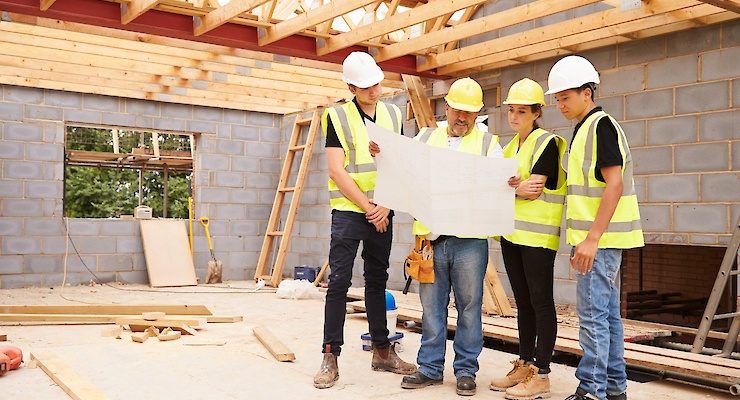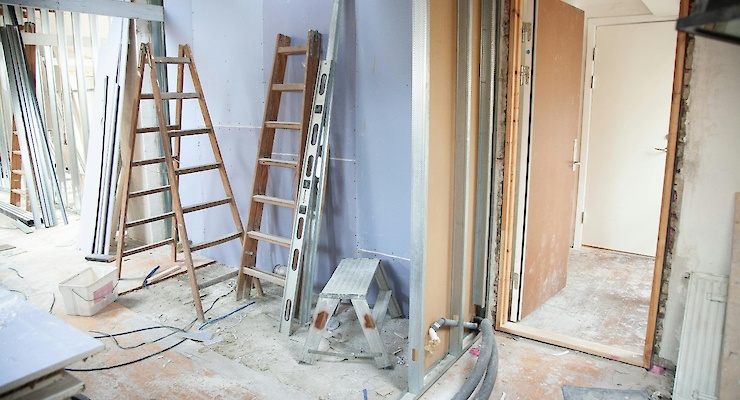


Head of Content

Mortgage Advisor & Director

Welcome to our complete guide to self-build mortgages. Here you will learn how they work, how to get one, and how we can help you get the best possible deal.
What is a self-build mortgage?
A self-build mortgage is a type of finance you can apply for if you are building a property yourself and need to borrow money to fund its construction.
They are similar to residential mortgages except the funds are released in stages as parts of the development are completed. For example, the first payment is typically made as you buy the land, and the final ones after the roof and interior walls are in place.
There are two types of self-build mortgages and the way they pay out sets them apart:
- Arrears: Funds are drawn down at the end of each stage, upon its successful completion. This type of self-build mortgage is designed for borrowers who have capital available to foot the initial costs for the project, which are then recouped.
- Advance: Funds can be drawn down at the beginning of each stage. These mortgages are aimed at self-builders with no immediate capital to get the project off the ground, but are higher risk for lenders and can be more difficult to come by.
Although self-build mortgages can be complex, support is available. There are mortgage brokers at Teito who specialise in this type of finance, and they can help you decide whether it’s the right option for you, and secure the best deal if that’s the case.
How exactly do they work?
The funds are released as staged drawdowns, as we have already touched on. This capital is used to cover the cost of each phase of the property’s construction.
Self-build mortgage payments are typically dished out at the following milestones:
- Land purchase (outline planning permission needed)
- Substructure
- Wallplate/eaves height (before the roof trusses are installed)
- Roof tiling (watertight and windproof)
- First fix
- Second fix
- Final payment on completion
It is common for lenders to carry out site inspections after each stage has been completed so they can be confident the work is progressing as planned and on budget.
Once the property has been completed most mortgage lenders will offer you the opportunity to remortgage onto a standard residential mortgage agreement, provided the home is habitable, has had a valuation carried out on it, and has been certified by a solicitor.
Self-build mortgage calculator
You can use our self-build mortgage calculator below to get a rough idea of how much your monthly repayments will be based on how far into the project you are.
This tool allows you to add tranches to your calculations and will work out the running cost based on how many of them you have drawn down. It can be useful for self-builders who are in the middle of a project and know how much they are borrowing for each stage of it, as well as those who have done estimates for the amount they will need for each tranche in advance.
Total Amount Borrowed: £0.00
Monthly Repayments: £0.00
It's important to note that you will only be charged interest on the funds you have actually drawn down and most lenders will be happy for you to pay only the interest while the work is in progress.
This can help you keep your initial costs down. The capital debt is most commonly repaid when you remortgage onto a residential agreement at the of the term.
How affordability is calculated
As self-build mortgages can be complex, you won’t find many bespoke calculators online to work out exactly how much you can borrow. As a general rule, though, the ceiling will typically be up to 75-85% of the approximate value of the property upon completion.
There are also maximum borrowing caps you should be aware of, with some lenders unable to offer loans for more than £1-2 million. Your upper borrowing limit might be smaller if you are a first-time buyer, but the good news is that there are lenders with much higher caps too.
You can read more about of self-build mortgage affordability and repayments work in our standalone guide.
Eligibility criteria

The eligibility criteria that most UK lenders use for self-build mortgages is as follows:
Experience & expertise
The mortgage lender will be keen to assess the expertise of the person carrying out the works to ensure they are qualified. If you are doing the building work yourself or directly overseeing it, your chances of mortgage approval will be significantly higher if you have prior experience with property development, either in a personal or professional capacity.
If you are hiring external contractors to take care of the labour, your mortgage provider might also look into their track record to ensure that the plans are achievable.
How much deposit you will need
Self-build mortgages have higher deposit requirements than standard residential mortgages. The minimum amount of deposit you will need to get approved is 15-20% of the property's estimated valuation upon completion, compared to 5-10% for a residential mortgage.
It is, however, not uncommon for some lenders to ask for 30-40% deposit for this type of finance. Your best chance of finding a low deposit option is through a broker.
Planning permission
You will need at least outline planning permission in place to get approved for a self-build mortgage, but obtaining full permission before you get started can help your cause.
If you already own the land outright and have planning permission in place, this can be advantageous, and could mean you can borrow more and are offered a better deal.
Other requirements
A strong self-build application is typically one where the borrower has development experience, a low loan-to-value (LTV) ratio and planning permission already in place; but there are general eligibility factors that can also affect your chances of mortgage approval.
Lenders prefer borrowers with no extra risk factors, which means that having bad credit, being 75 years of age or older during the mortgage term and using non-standard construction materials during development can hinder your chances of getting approved.
Speak to a broker if these risk factors are present to find out what your options are.
How to get a self-build mortgage
Follow the steps below to get started on your self-build mortgage journey:
Have your documents ready: You will need a copy of the building plans, planning permission and a cost breakdown. This is in addition to the usual mortgage paperwork, including proof of address, ID and three months’ bank statements.
Check your credit files: Having up-to-date credit files can strengthen your application. Download your reports from Checkmyfile and report any errors or outdated information to the credit reference agencies to have them removed or corrected.
Speak to a mortgage broker: Our brokers specialise on self-build mortgages. They can offer bespoke advice about them, application guidance and help you secure the best deal via their lender contacts - get started with one of our brokers here.
What interest rates to expect
Interest rates on self-build mortgages are generally higher than for residential mortgages due to the increased risk the lender is taking on. Rates in general can be 2-3 percentage points higher than equivalent residential deals, and fees are generally higher too.
The rate you qualify for will depend on a range of different factors, including:
- LTV: The best rates are reserved for borrowers with lower LTVs (60% or less).
- Product type: Arrears-based self-build mortgages tend to have lower interest rates than deals where the payments are made ahead of each stage.
- Other factors: The overall strength of your borrowing profile will determine the number of rates and deals you have access to.

Speak to a self-build mortgage specialist today
Which lenders are available?
At the time of writing, there are around 28 lenders available for self-build mortgages. These are typically specialist mortgage providers and regional building societies, some of which are only accessible to borrowers who are applying through a mortgage broker.
The table below shows examples of lenders who currently offer self-build mortgages:
Mortgage Lender | Criteria For Self-Builds |
Only available in Cumbria,Northumberland, Tyne & Wear, County Durham, Yorkshire, Lancashire, Dumfries & Galloway, and the Scottish Borders | |
LTV capped at 80% in England & Wales, and 75% in Scotland | |
Maximum LTV is 75% | |
No specific caveats specified |
Most high street mortgage lenders do not offer self-build mortgages, although this wasn’t always the case. Halifax, for example, were once in this market before withdrawing from it.
We can help you access 100% of the self-build mortgage market as our brokers have working relationships with the specialist and intermediary-only lenders who offer them.
Are self-build mortgages worth it?
The table below shows the advantages and disadvantages of a self-build mortgage at a glance to help you decide whether it is the right type of finance for you:
Advantages | Disadvantages |
No stamp duty payable on building work or property value on completion. Only land is subject to this tax, if its cost exceeds £125k | Interest rates and deposit requirements can be higher than alternative types of finance |
Can potentially work out cheaper than buying a completed property, provided the development goes to plan | Limited choice of mortgage lenders are available for this type of finance |
Borrowers can tailor their property to their own tastes and standards | Higher risk due to possibility of delays and project running over budget |
Some self-builders find that the property value is higher than the building and land purchase costs after completion | Application process can take longer due to extra steps, such as finding labourers and obtaining planning permission |
Alternatives to consider
Self-build mortgages aren’t your only option if you are planning to build a property to live in. You should speak to a broker about the alternatives, but here is an overview of them:
- Bridging loans: These short-term loans can be used to cover the cost of the site purchase and construction work. They are very quick to arrange and can be viable if time is off the essence, but interest rates can be significantly higher.
- Remortgaging a property you own: If you already own a property, you could release capital for the construction of a new one via a remortgage. This can be an alternative if you have enough equity built up to fund the project.
- Personal loans or savings: Depending on the amount your self-build project is expected to cost, taking out a personal loan or using your personal savings might be a cost-effective alternative, but this may not be an option for large-scale projects.
The above are merely a handful of alternatives. If you own land or property, there may be other ways you could raise capital from them, such as secured loans, equity release, or selling the assets altogether. Speak to one of our brokers for bespoke advice on this.
Why choose Teito for your self-build mortgage?
Self-build mortgages can be complex and costly, but with the right advice, that doesn’t have to be the case. At Teito, we have brokers who specialise in this type of finance and they can take the stress out of your mortgage journey and make sure you get the best deal.
Here are just some of the reasons you should choose our self-build mortgage brokers:
- They can offer bespoke advice about this type of finance
- They can access exclusive deals from self-build lenders
- They can provide personalised calculations and help with paperwork
- Our brokerage is 5-star rated on leading review websites
Ready to take advantage of a free, no-obligation consultation with a broker who specialises in self-build mortgages? Get started here.
FAQs
Yes. The criteria for this type of finance can be more stringent and there are extra steps to go through, such as obtaining planning permission and drawing up the building plans.
There are also fewer lenders available since self-build mortgages are a niche type of borrowing, and applicants may not be approved without construction experience.
Choosing an Adviser
Selecting a qualified and experienced mortgage adviser is of great importance. To choose a suitable adviser, evaluate their qualifications, experience, and reputation, and ensure they are regulated by the Financial Conduct Authority (FCA).
Read reviews from previous clients and make sure they provide a clear explanation of the products and services they offer, as well as the fees and charges associated with them.













































































